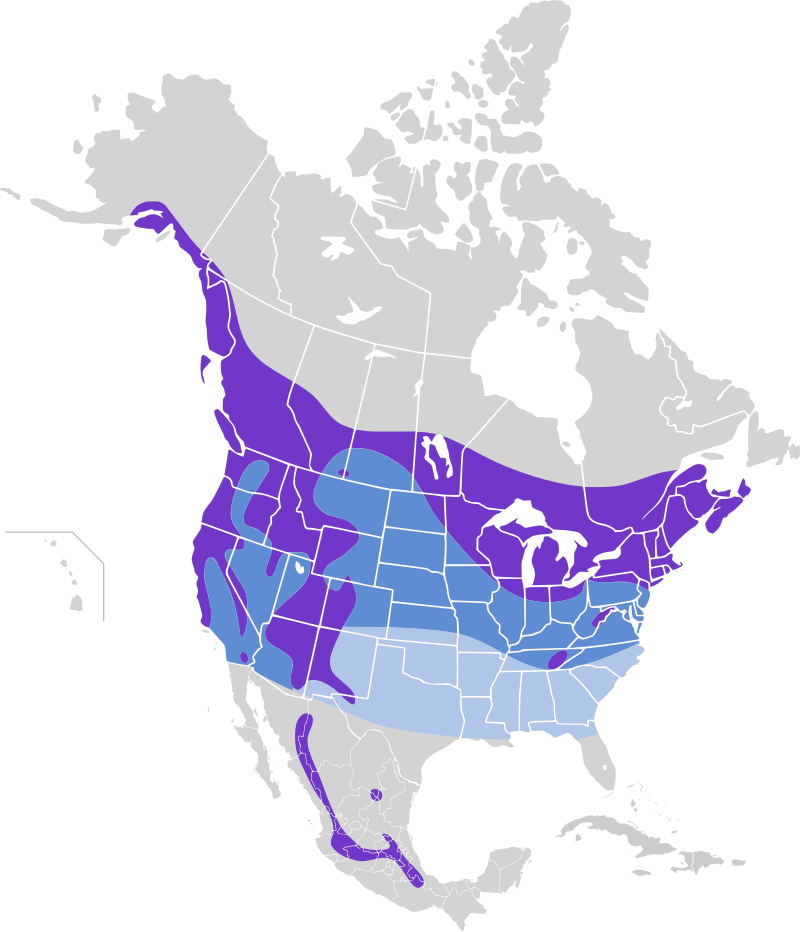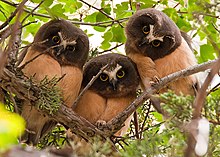
Description
The scientific description of one of the sub-species of this owl is attributed to the Rev. John Henry Keen who was a missionary in Canada in 1896.[2] Adults are 17–22 cm (6.7–8.7 in) long with a 42–56.3 cm (16.5–22.2 in) wingspan.[3][4] They can weigh from 54 to 151 g (1.9 to 5.3 oz) with an average of around 80 g (2.8 oz),[5][6] making them one of the smallest owls in North America.[7] They are close to the size of an American robin. The northern saw-whet owl has a round, light, white face with brown and cream streaks; they also have a dark beak and yellow eyes. They resemble the short-eared owl, because they also lack ear tufts, but are much smaller. The underparts are pale with dark shaded areas; the upper parts are brown or reddish with white spots. They are quite common, but hard to spot.Voice
The northern saw-whet owl makes a repeated tooting whistle sound. Some say they sound like a saw being sharpened on a whetstone.[8] They usually make these sounds to find a mate, so they can be heard more often April through June when they are looking for mates. Despite being more common in spring, they do vocalize year round.Hearing
The northern saw-whet owl has a very sophisticated hearing. It is due to vertically asymmetrical ears and different shape of the ear openings. Because the sound reaches the ears at a different time and is of different intensity, the northern saw-whet owl can very precisely localize its prey. Such accurate sound localization allows it to hunt in a complete darkness by hearing alone.[9][10]Habitat
Their habitat is coniferous forests, sometimes mixed or deciduous woods, across North America. Most birds nest in coniferous type forests of the North but winter in mixed or deciduous woods. They also love riparian areas because of the abundance of prey there.[11] They live in tree cavities and old nests made by other small raptors. Some are permanent residents, while others may migrate south in winter or move down from higher elevations. Their range covers most of North America including southeastern and southcentral Alaska, southern Canada, most of the United States and the central mountains in Mexico.Some have begun to move more southeast in Indiana and neighboring states. Buidin et al. did a study of how far north the northern saw-whet owls breed and they found that they can breed northward to > 50° N, farther than ever recorded before.[12] Their range is quite extensive and they can even breed in the far north where most birds migrate from to breed. They are an adaptive species that can do well in the cold.
Nesting
Three juveniles in Oregon, United States
Feeding
These birds wait on a high perch at night and swoop down on prey. They mainly eat small organisms with a strong focus on small mammals in their diet. Swengel and Swengel (1992) reviewed ten studies that found northern saw-whet owls eating almost exclusively mammals (88% to 100%), with most of the mammals being rodents (85% to 99+%). Specifically in their Wisconsin study, the Swengels counted Saw-whets as most often eating deer mice, (Peromyscus; ~ 68% of captured prey), voles, (Microtis pennsylvunicus and M. ochroguster; ~ 16%), and shrews (~ 9%; Blurinu brevicuudu and Sorex cinereus).[14] A similar study by Holt and Leroux (1996) in Montana found saw-whet owls eating more voles (60%) than other mammal species.[15] Engel et al. (2015) also found in the saw-whet owl a strong preference for small mammals (89%), with 55% of prey being two species of voles.
On a daytime hunt in a brushy area, Homer, Alaska
Other mammals preyed on occasionally include shrews, squirrels (largely chipmunks and red squirrels), various other mice species, flying squirrels, moles and bats. Also supplementing the diet are small birds, with passerines such as swallows, sparrows, kinglets and chickadees favored. However, larger birds, up to the size of rock pigeon (which are typically about 4 times as heavy as a saw-whet) can even be taken.[13] On the Pacific coast they may also eat crustaceans, frogs and aquatic insects. Like many owls, these birds have excellent hearing and exceptional vision in low light.
Aegolius acadicus acadicus
Aegolius acadicus brooksi

Nyctala acadica


No comments:
Post a Comment
Note: Only a member of this blog may post a comment.